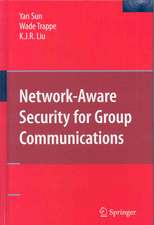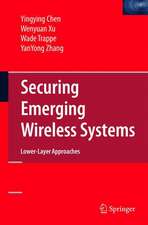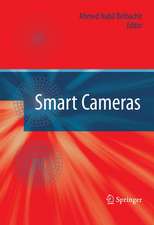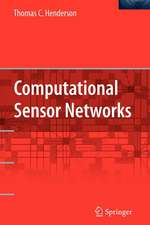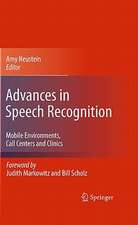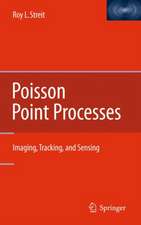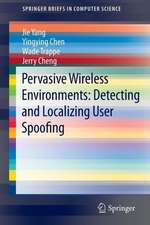Securing Wireless Communications at the Physical Layer
Editat de Ruoheng Liu, Wade Trappeen Limba Engleză Paperback – 7 sep 2014
| Toate formatele și edițiile | Preț | Express |
|---|---|---|
| Paperback (1) | 950.03 lei 6-8 săpt. | |
| Springer Us – 7 sep 2014 | 950.03 lei 6-8 săpt. | |
| Hardback (1) | 956.18 lei 6-8 săpt. | |
| Springer Us – 10 dec 2009 | 956.18 lei 6-8 săpt. |
Preț: 950.03 lei
Preț vechi: 1158.57 lei
-18% Nou
Puncte Express: 1425
Preț estimativ în valută:
181.81€ • 189.11$ • 150.10£
181.81€ • 189.11$ • 150.10£
Carte tipărită la comandă
Livrare economică 12-26 aprilie
Preluare comenzi: 021 569.72.76
Specificații
ISBN-13: 9781489983756
ISBN-10: 1489983759
Pagini: 412
Ilustrații: XVI, 396 p.
Dimensiuni: 155 x 235 x 22 mm
Greutate: 0.58 kg
Ediția:2010
Editura: Springer Us
Colecția Springer
Locul publicării:New York, NY, United States
ISBN-10: 1489983759
Pagini: 412
Ilustrații: XVI, 396 p.
Dimensiuni: 155 x 235 x 22 mm
Greutate: 0.58 kg
Ediția:2010
Editura: Springer Us
Colecția Springer
Locul publicării:New York, NY, United States
Public țintă
ResearchCuprins
Secrecy Capacity of Independent Parallel Channels.- Obtaining Secrecy through Intentional Uncertainty.- Distributed Secret Sharing over the Gaussian Interference Wiretap Channel.- Cooperative Jamming: The Tale of Friendly Interference for Secrecy.- Hybrid-ARQ Schemes for Reliable and Secret Wireless Communications.- Secret Communication Under Channel Uncertainty.- Cooperative Secrecy in Wireless Communications.- Source Coding under Secrecy Constraints.- Secret Key Extraction from Level Crossings over Unauthenticated Wireless Channels.- Secret Key Generation Among Multiple Terminals with Applications to Wireless Systems.- Secret Key Agreement Techniques based on Multipath Propagation Characteristics.- Secret Communication over Fading Channels.- Fingerprints in the Ether: Channel-Based Authentication.- Message Authentication: Information Theoretic Bounds.- Trusted Cooperative Transmissions: Turning a Security Weakness into a Security Enhancement.- Modulation Forensics for Wireless Digital Communications in Frequency-Selective Fading Channels.
Textul de pe ultima copertă
Wireless systems are becoming increasingly pervasive and securing these systems has been challenging, in large part due to the unique properties associated with wireless communications. Securing these networks has traditionally been approached by taking a conventional approach involving cryptographic protocols. Such an approach inherently seeks to secure the wireless network at the link layer and above, and consequently fails to leverage the most unique characteristic of wireless communication: its physical layer.
Securing Wireless Communications at the Physical Layer is a compilation of contributions by experts in wireless communications and security, and presents state-of-the-art results that examine the challenge of introducing security at the physical layer of a wireless system. Throughout this book there is an underlying theme that the rich multipath environment that is typical of wireless scenarios supports the establishment of new security services at the physical layer, including new mechanisms that establish cryptographic keys, that support communication with assured confidentiality, and that can authenticate transmitters in mobile environments. The book takes a holistic approach to covering topics related to physical layer security solutions, with contributions ranging from the theoretical underpinnings behind secure communications to practical systems validations that have been performed on real wireless systems. The book also covers topics related to ensuring that cooperative wireless communications at the physical layer is trustworthy. Additionally, the emerging area of modulation forensics, whereby a device is able to identify the modulation format being employed by other devices is explored.
Securing Wireless Communications at the Physical Layer will serve as a valuable reference to engineers and researchers in the fields of security and wireless communications.
Securing Wireless Communications at the Physical Layer is a compilation of contributions by experts in wireless communications and security, and presents state-of-the-art results that examine the challenge of introducing security at the physical layer of a wireless system. Throughout this book there is an underlying theme that the rich multipath environment that is typical of wireless scenarios supports the establishment of new security services at the physical layer, including new mechanisms that establish cryptographic keys, that support communication with assured confidentiality, and that can authenticate transmitters in mobile environments. The book takes a holistic approach to covering topics related to physical layer security solutions, with contributions ranging from the theoretical underpinnings behind secure communications to practical systems validations that have been performed on real wireless systems. The book also covers topics related to ensuring that cooperative wireless communications at the physical layer is trustworthy. Additionally, the emerging area of modulation forensics, whereby a device is able to identify the modulation format being employed by other devices is explored.
Securing Wireless Communications at the Physical Layer will serve as a valuable reference to engineers and researchers in the fields of security and wireless communications.
Caracteristici
A collection of high-impact research results in the area of physical layer security will serve as a valuable compendium to any researcher interested in conducting research in physical layer security The book will be broken down into five sections, corresponding to major thematic areas related to physical layer security The editorial team will provide perspectives for the chapters in each section The two major forms of physical layer confidentiality will be covered—secrecy extraction and secrecy dissemination Physical layer authentication will be discussed, providing a coverage of physical layer security that extends beyond the conventional "secrecy"-oriented approaches to security Includes supplementary material: sn.pub/extras

